This Pad Thai recipe is fast and easy to make with simple, authentic ingredients in under 30 minutes! Add shrimp, chicken, or tofu for a delicious vegetarian version. Video.
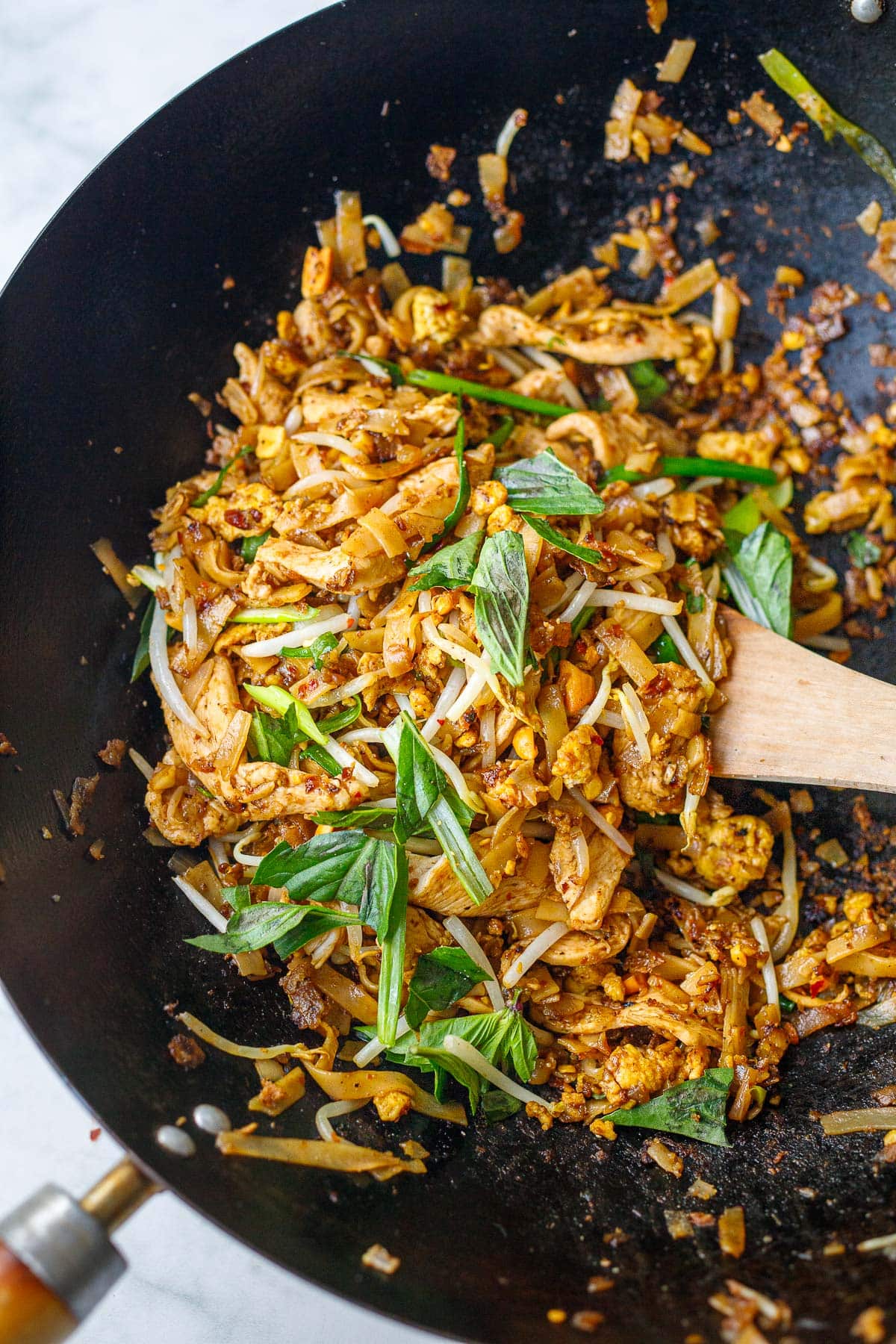
As a chef and caterer, I’ve cooked and eaten a lot of Pad Thai in my lifetime, both here and all throughout Thailand. We’ve captured the authentic flavor you’ll find in Bangkok while keeping the ingredients simple and the cooking fast and easy.
I may be biased, but I think this is the best Pad Thai recipe around—not overly sweet like many Americanized versions. You’ll find no ketchup or peanut butter in this recipe. But don’t take my word for it; just read all our great reviews!
But first, What is Pad Thai?
Pad Thai is a popular stir-fried noodle dish from Thailand made with rice noodles, shallot, garlic, scrambled eggs, and a protein, typically chicken or shrimp, in a flavorful, tangy, umami Pad Thai Sauce. It’s served with fresh bean sprouts, crushed peanuts, scallions and lime.
Why this Pad Thai Recipe is the Best!
- Balanced Flavor. Pad Thai sauce is a delicate balance between umami, sourness, and sweetness. Most American versions are way too sweet; this one is just right.
- It’s adaptable! This recipe can be made with chicken, shrimp, tofu and /or veggies! Gluten-free, vegetarian and vegan-adaptable.
- Quick and Easy– Once the ingredients are prepped, this takes 15 minutes of cooking time!
- Simple Ingredients. These accessible ingredients can be found in most grocery stores.
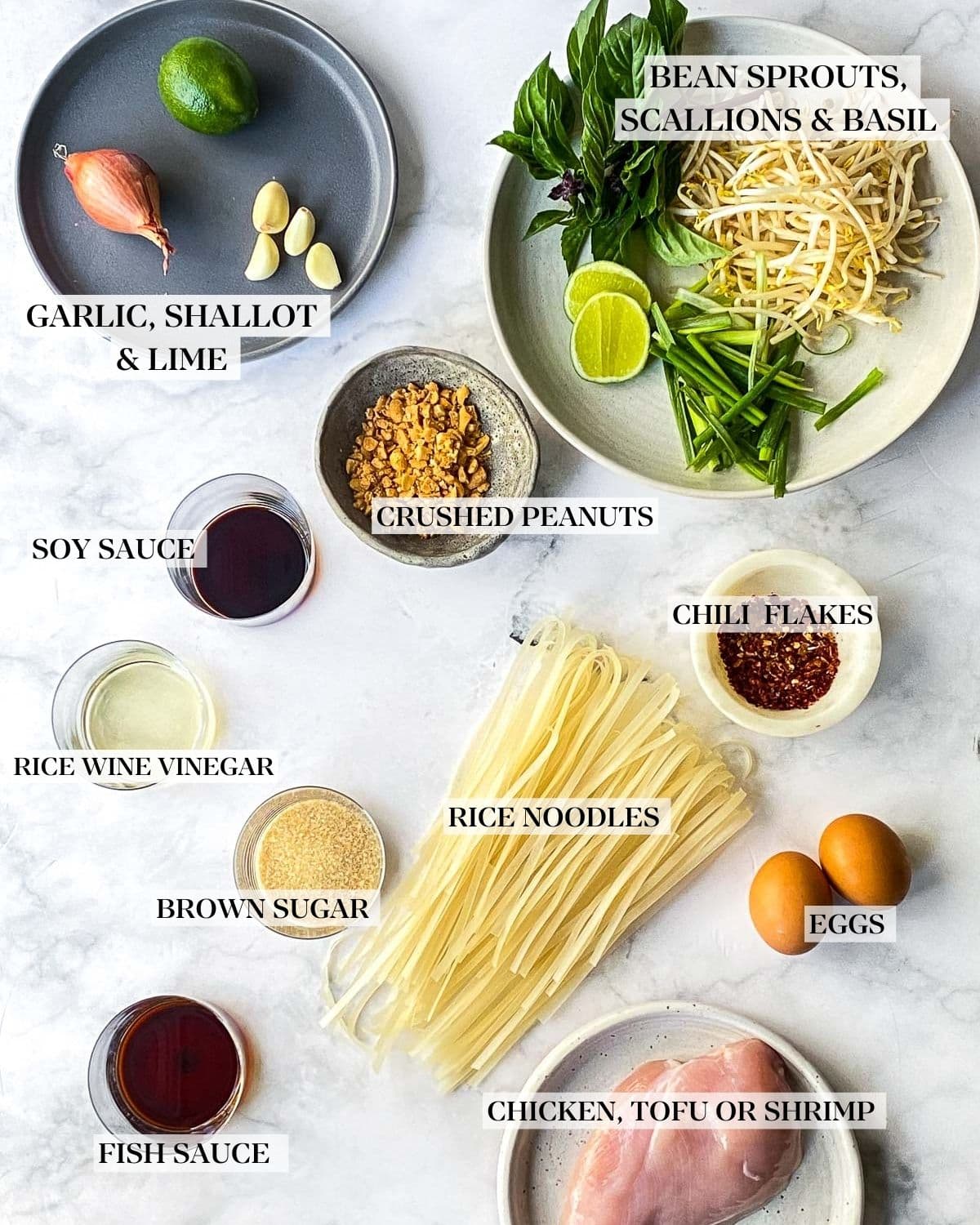
Pad Thai Ingredients
- Rice Noodles: Pad Thai is typically made with noodles called “rice stick”, which are rice noodles that are about 1/4 inch wide. Some brands are better than others- many fall apart when stir-frying. I have had the best luck with Thai Kitchen rice noodles. Make sure to soak the noodles, rather than boil, to prevent breaking.
- Protein: Add thinly sliced chicken breast, shrimp, or crispy Tofu, or leave out the protein and add stir-fried veggies. Extra firm tofu works best.
- Eggs: Traditional pad thai has scrambled eggs, vegans can leave this out.
- Garlic cloves and shallots: Shallots really elevate Pad Thai. I highly recommend shallots over onions if possible. Some versions use ginger, but in Thailand, they generally don’t.
- Fresh Lime Juice: adds acidity.
- Garnishes: The garnishes make Pad Thai, adding texture and flavor. Sliced green onions, crushed roasted peanuts, fresh bean sprouts, Thai chili flakes and lime wedges and if available, Thai basil, all elevate!
Pad Thai Sauce Ingredients
The secret to the best Pad Thai Sauce is the perfect balance of salty, sweet and sour. Our sauce has delicious umami and depth, while not being overly sweet with a lovely tang. Letting the sauce caramelize in the wok for just a few seconds, adds a lovely smokiness.
- Fish Sauce – Fish Sauce can vary in degrees of saltiness from brand to brand. I like Red Boat Fish sauce, or Thai Kitchen Fish Sauce (found at most grocery stores) best for this recipe. (*Vegans can sub our vegan fish sauce and soy sauce.) If you are new to fish sauce, keep in mind, it has a little “funk” to it. You can start off lighter and replace the rest with soy sauce.
- Tamarind Water or Rice Wine Vinegar – authentic Pad Thai is made with tamarind water and lime juice to give it the sour component, but feel free to use Rice Wine Vinegar and lime to keep things simple here. See recipe notes for using tamarind.
- Sugar – In Thailand, it is traditional to use palm sugar but we use brown sugar, coconut sugar or regular cane sugar to add sweetness. Note: Do not be tempted to cut back on the sugar, the Pad Thai will be too sour.
- Soy Sauce – adding a little soy sauce adds even more depth. You can also use gluten-free liquid aminos!
How to make Pad Thai (easy Instructions)
Step 1: Soak the rice noodles. Pour boiling water over the rice noodles let them soak until they are soft and pliable (about 5-6 minutes) but not overly soft; drain.
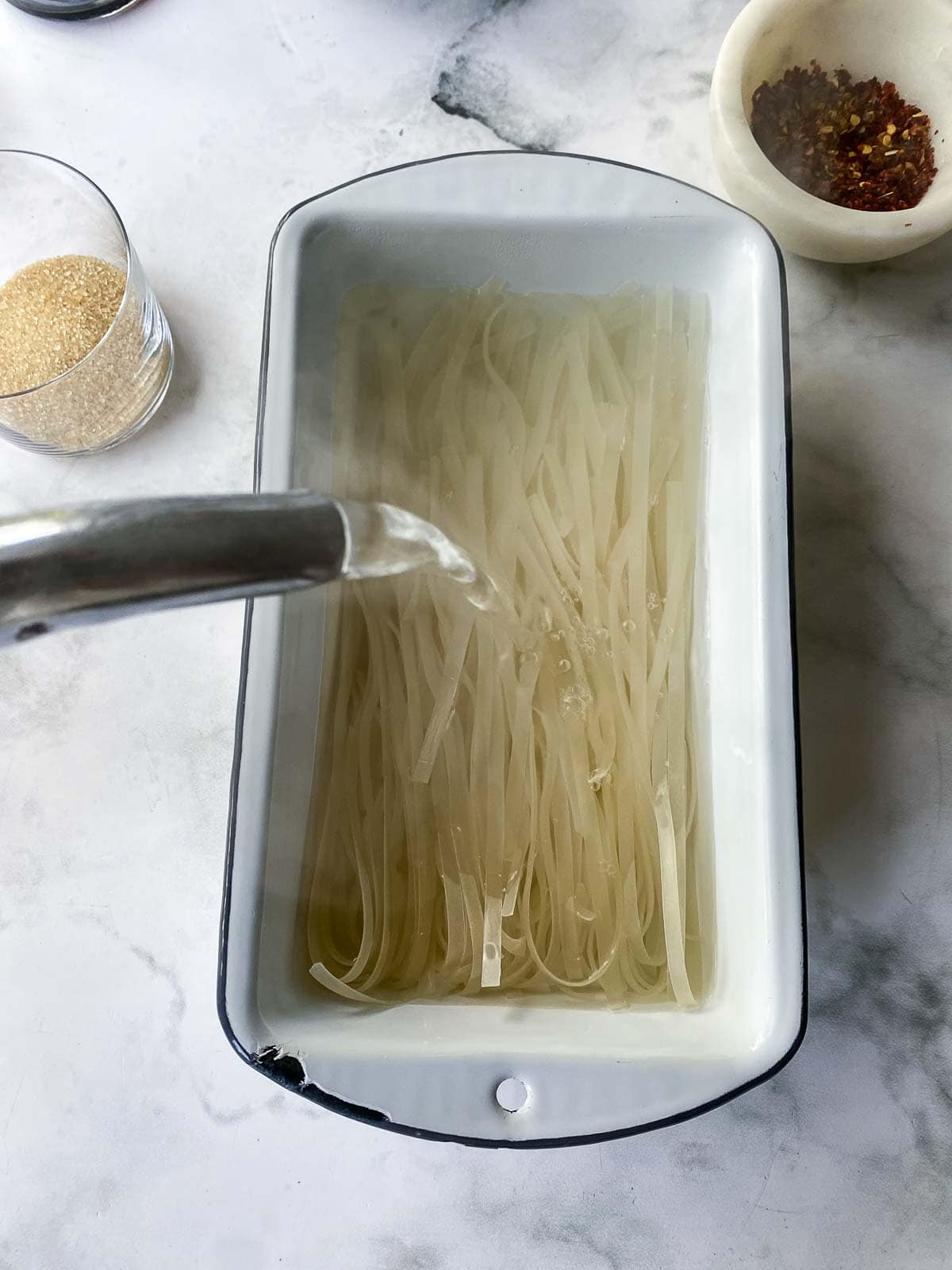
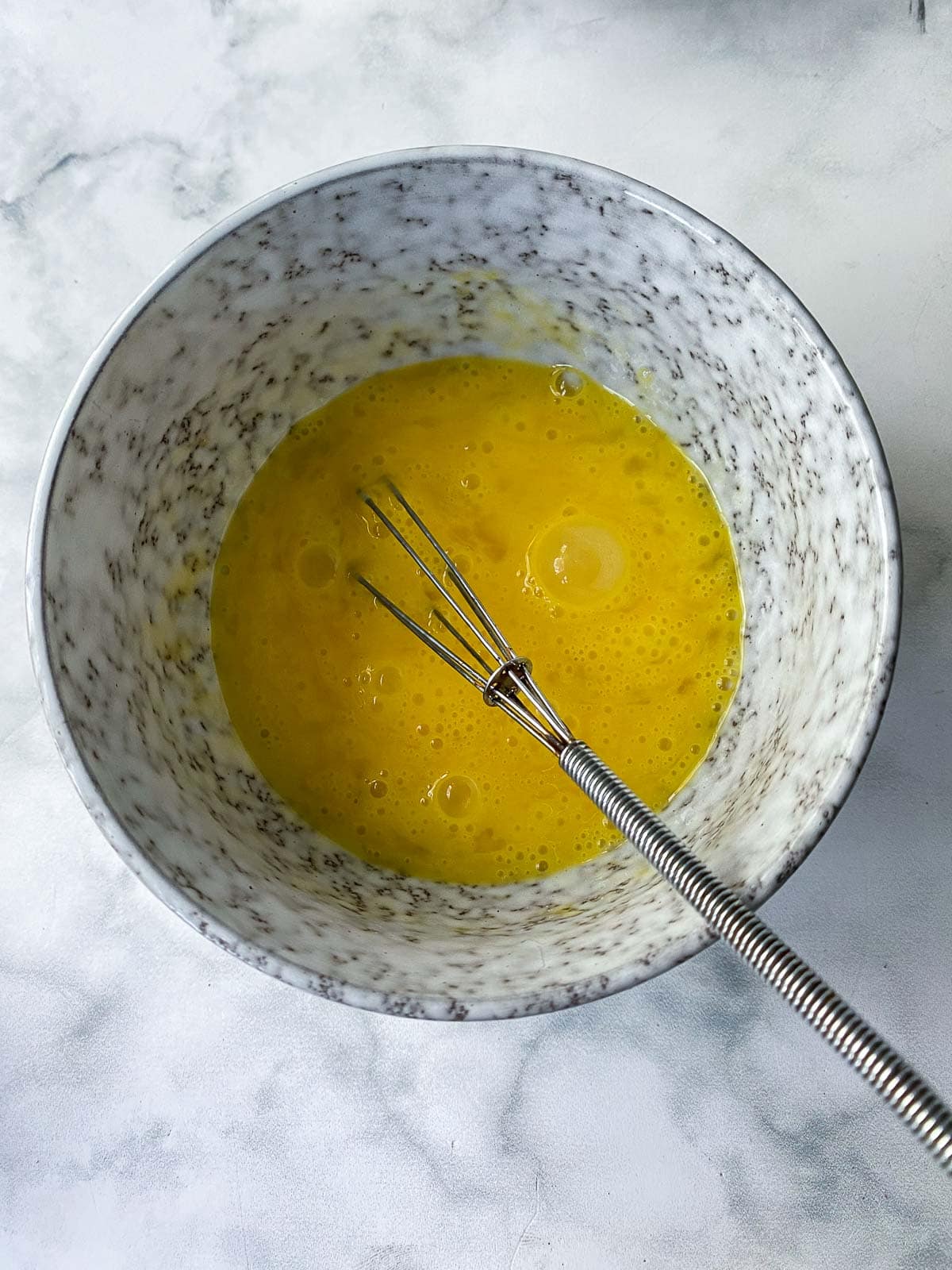
Step 2: Whisk the Eggs. Whisk the eggs in a medium bowl with a pinch of salt. Set aside by the stove.
Step 3: How to make Pad Thai Sauce. Whisk the pad thai sauce ingredients together in a small bowl- keeping in mind, there is a delicate balance between salty, sour and sweet, so if you alter one ingredient, you may need to adjust the others. Make sure the sugar completely dissolves.
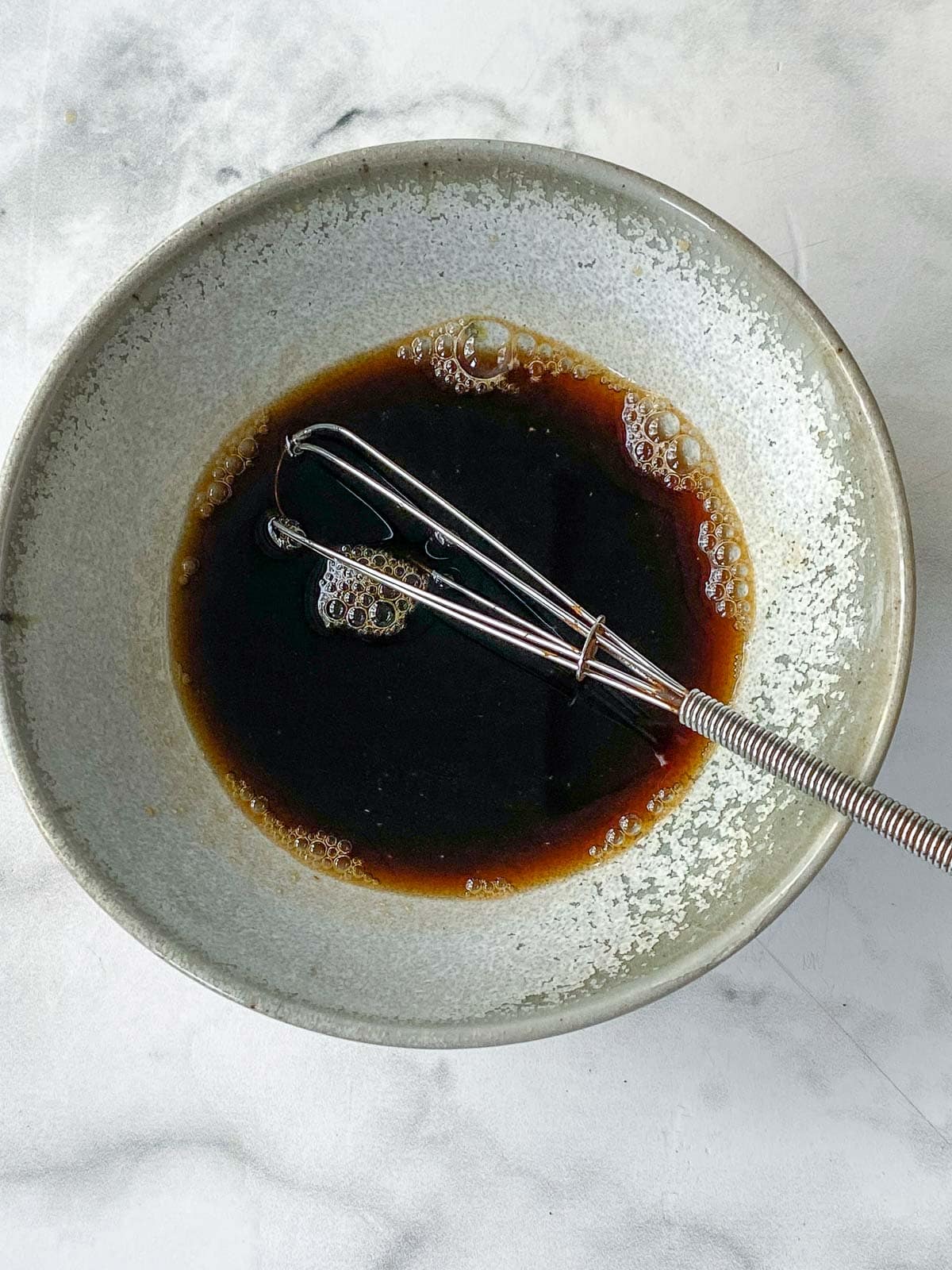
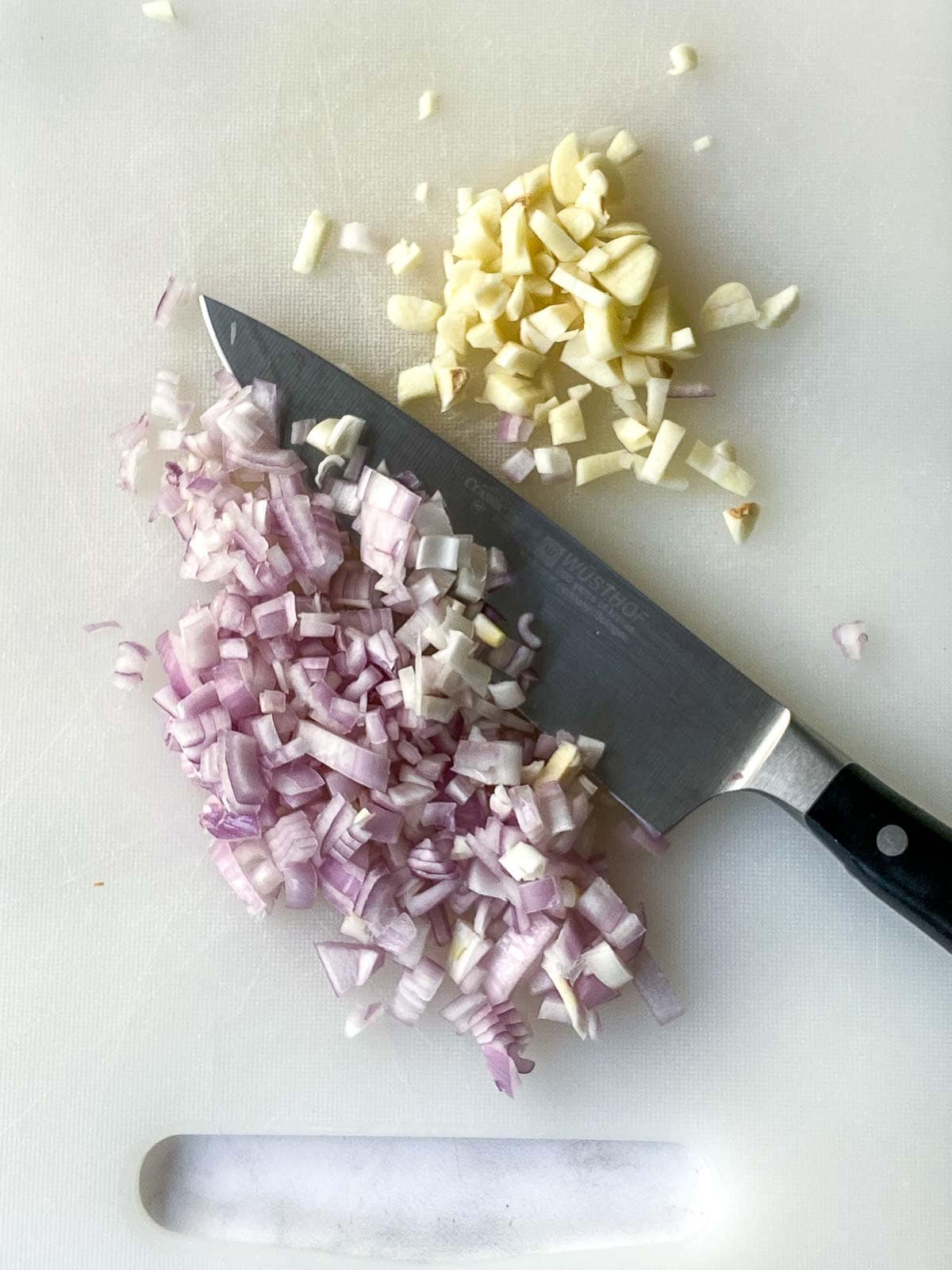
Step 4: Prep the Protein & Veggies. Chop the shallot and garlic finely and set aside. Slice chicken thinly across the grain (or peel and devein shrimp). If adding veggies, chop or slice them small, so they cook quickly in the wok.
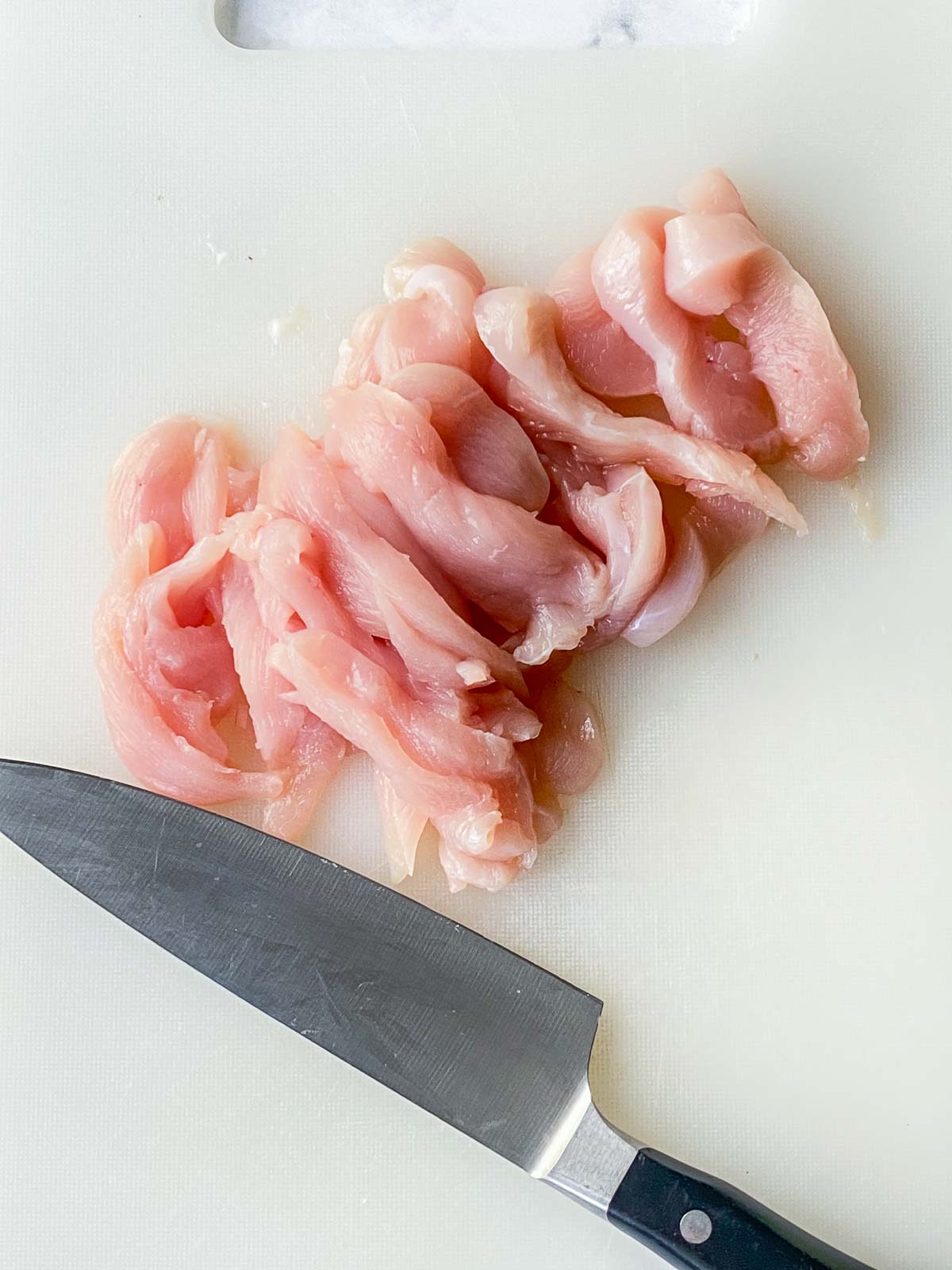
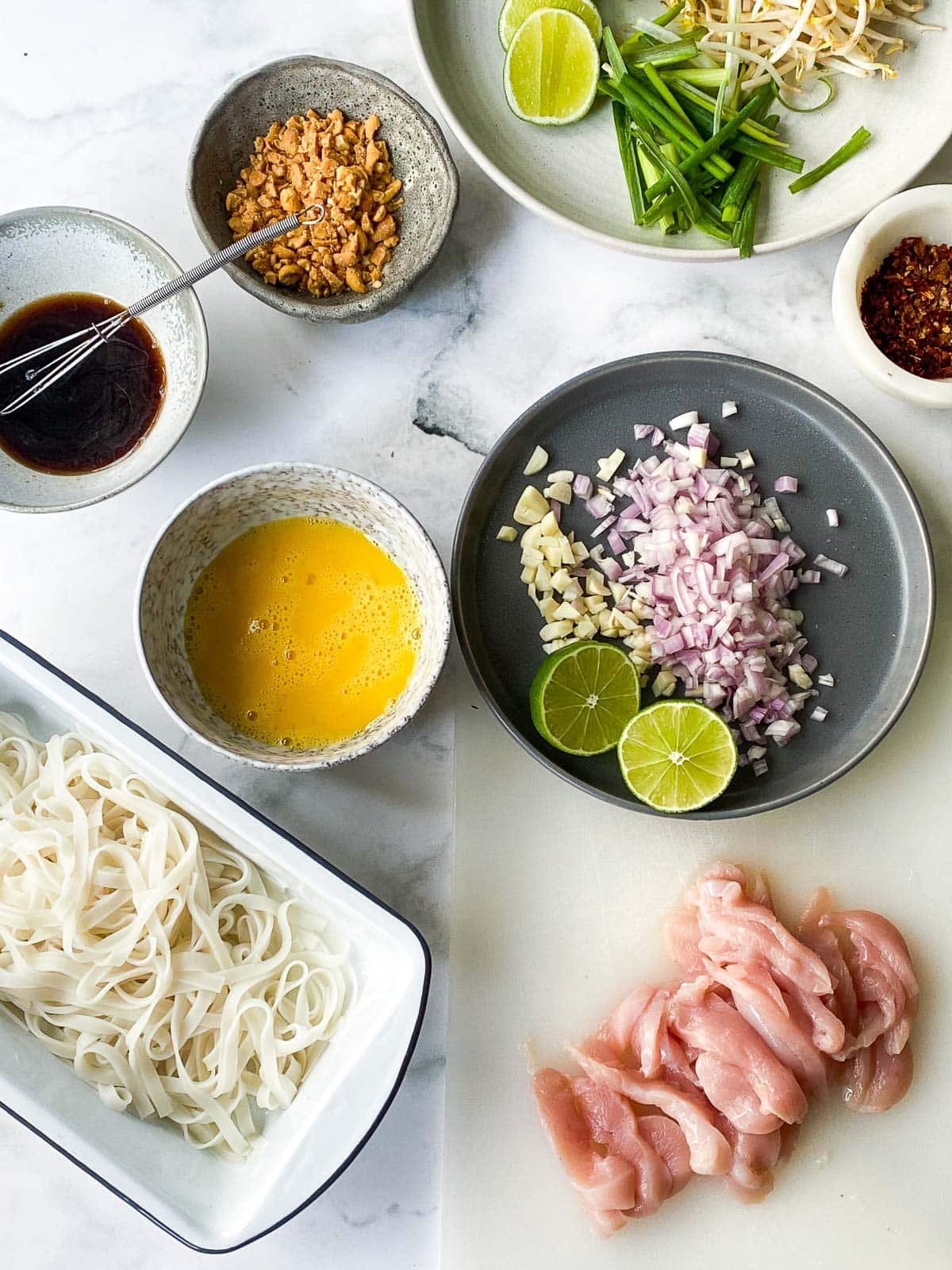
Step 5: Prep all your garnishes and have everything ready to go by the stove, keeping in mind the stir fry part will go quickly!
Step 6: Stir Fry! Season the protein with salt and pepper, and stir fry in a carbon steel wok until just cooked through and set it aside. If adding veggies, stir-fry these now and set aside as well.
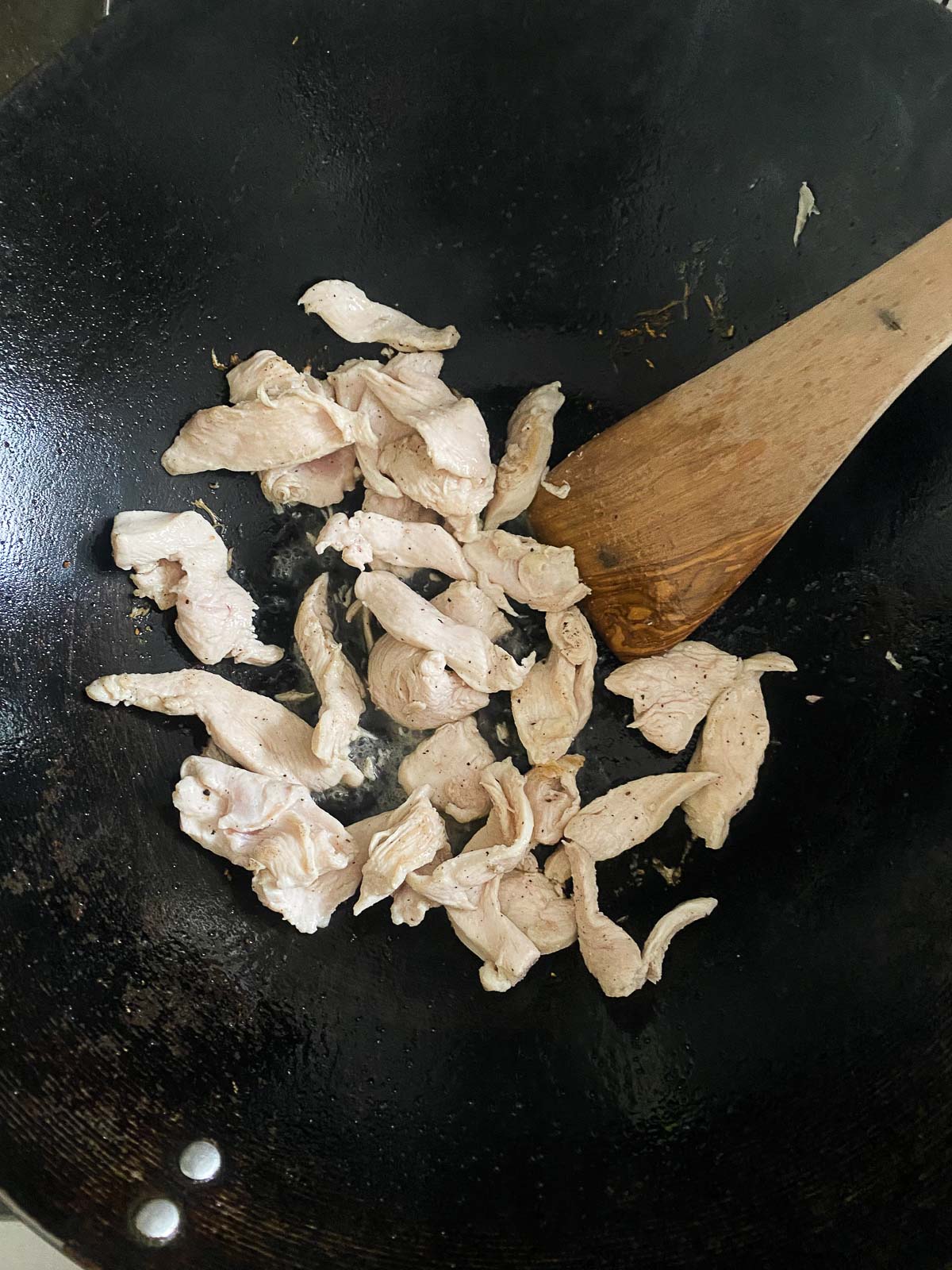
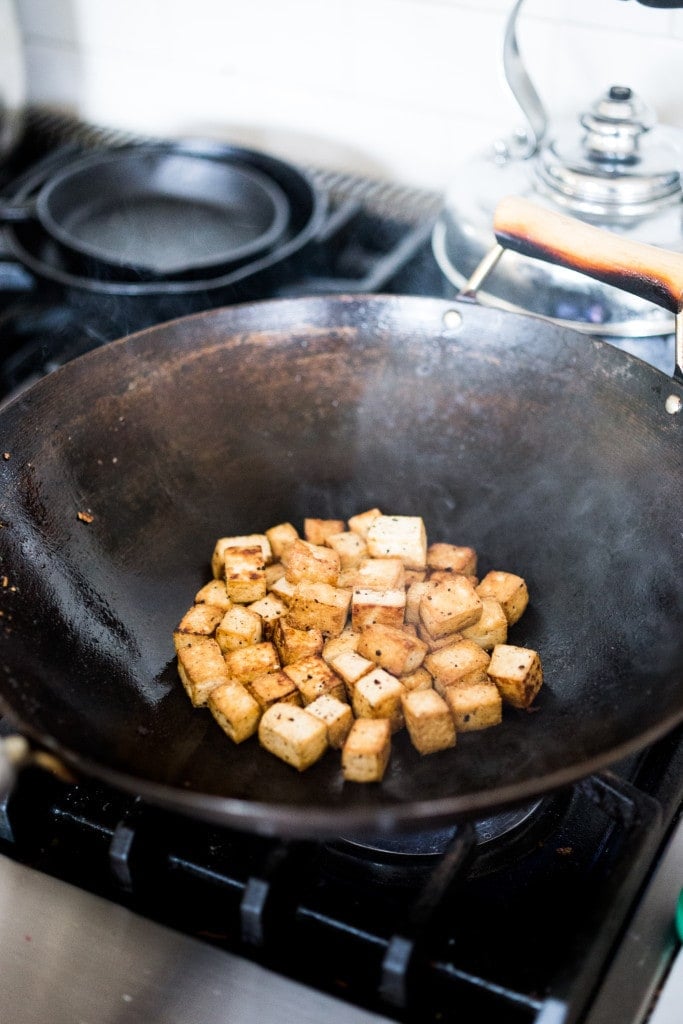
Add more oil to the wok and stir fry the garlic and shallots for just a couple minutes, scoot them over, add more oil if needed, and add the whisked the eggs, scrambling and breaking to bits.
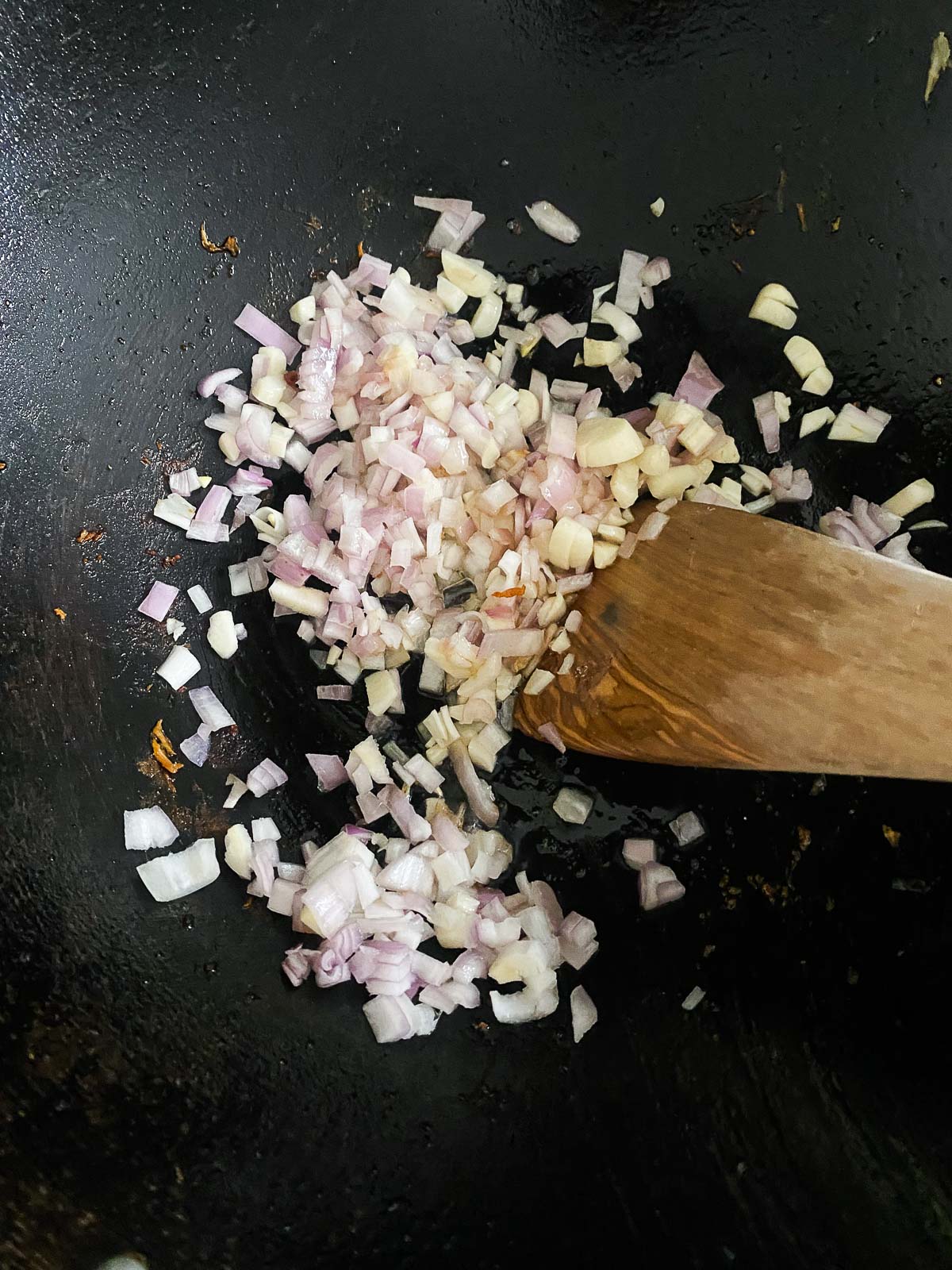
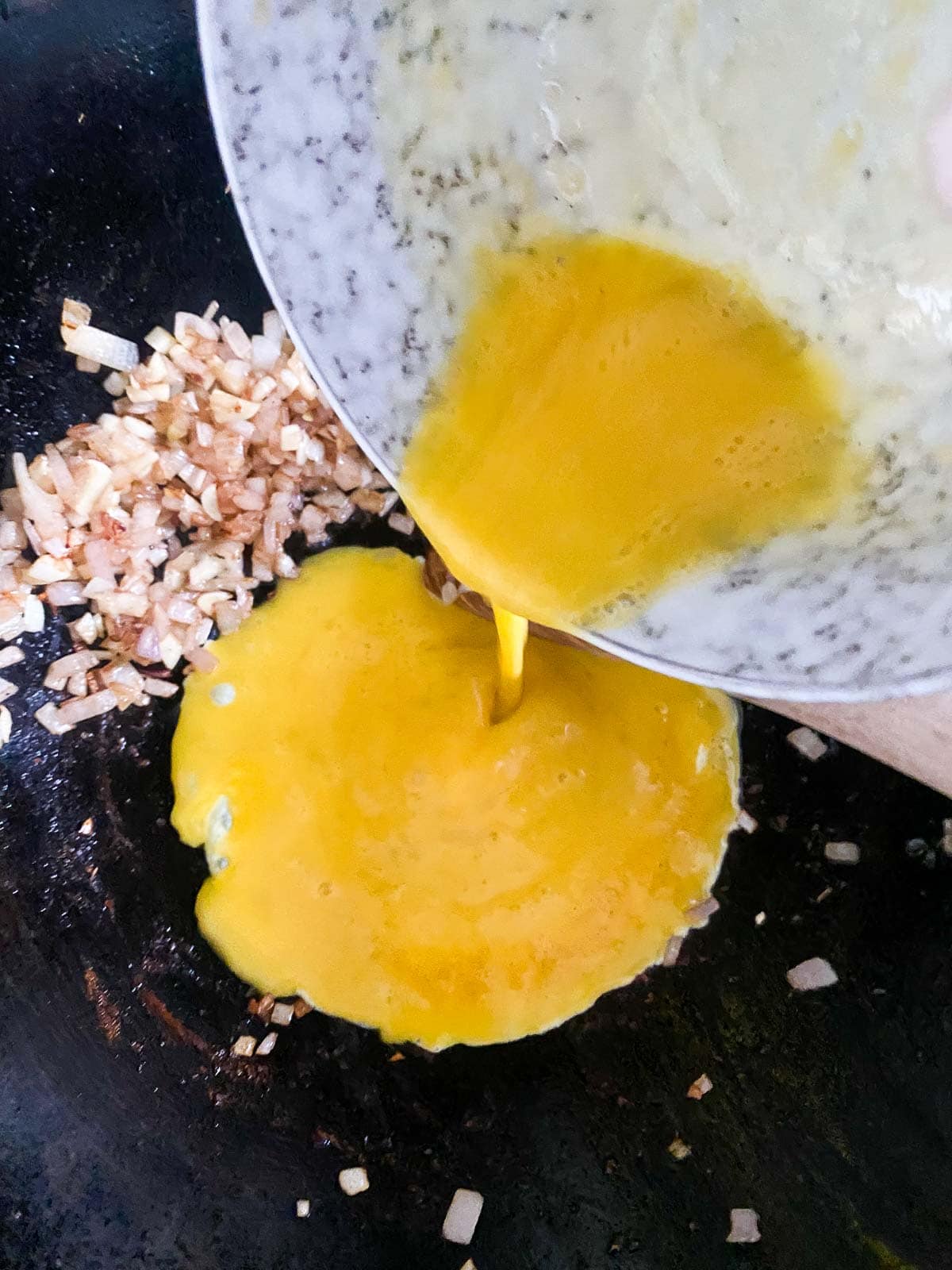
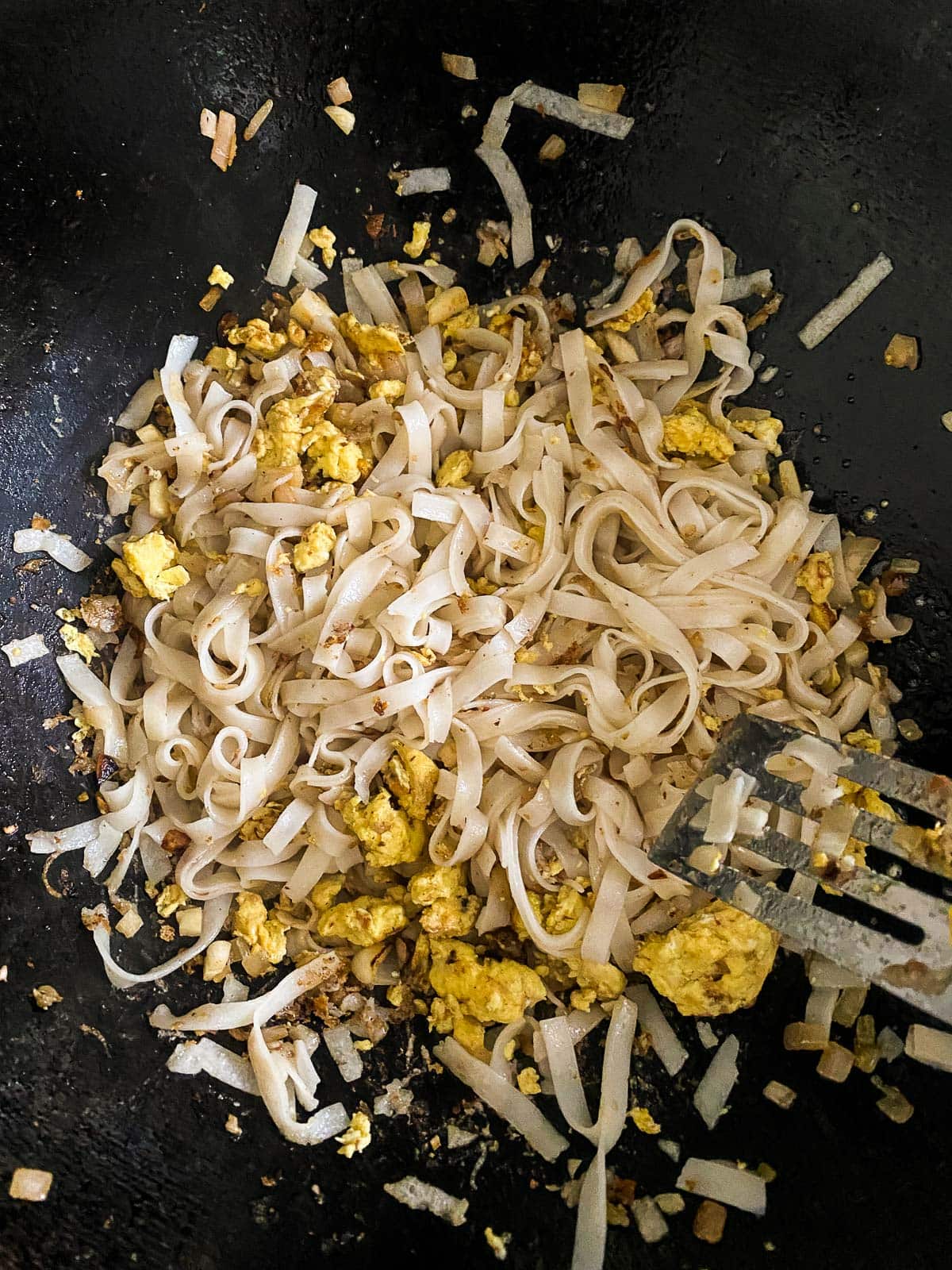
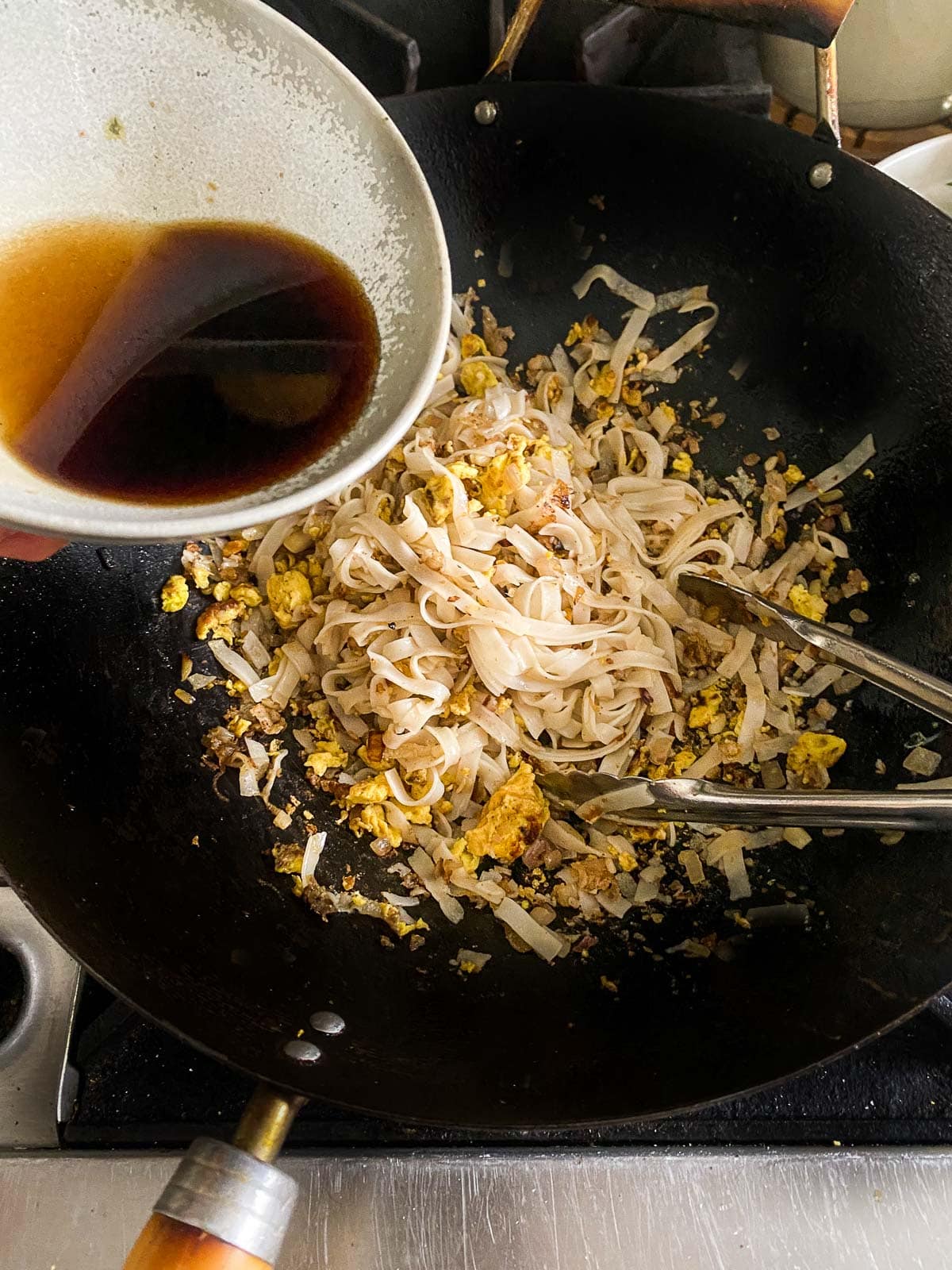
Scoot the eggs over and add more oil and stir fry the noodles, letting the noodles get a little crispy! Turn your hood on and pour in the Pad Thai Sauce. Let the sauce caramelize for 30 seconds, until you smell the sugar caramelizing. This will add great flavor!
Add back in the cooked protein and veggies, with some of the bean sprouts and scallions. Add a squeeze of lime.
*Taste and adjust salt, lime or sugar to taste. Find the perfect balance. See FAQ’s for troubleshooting the flavors.
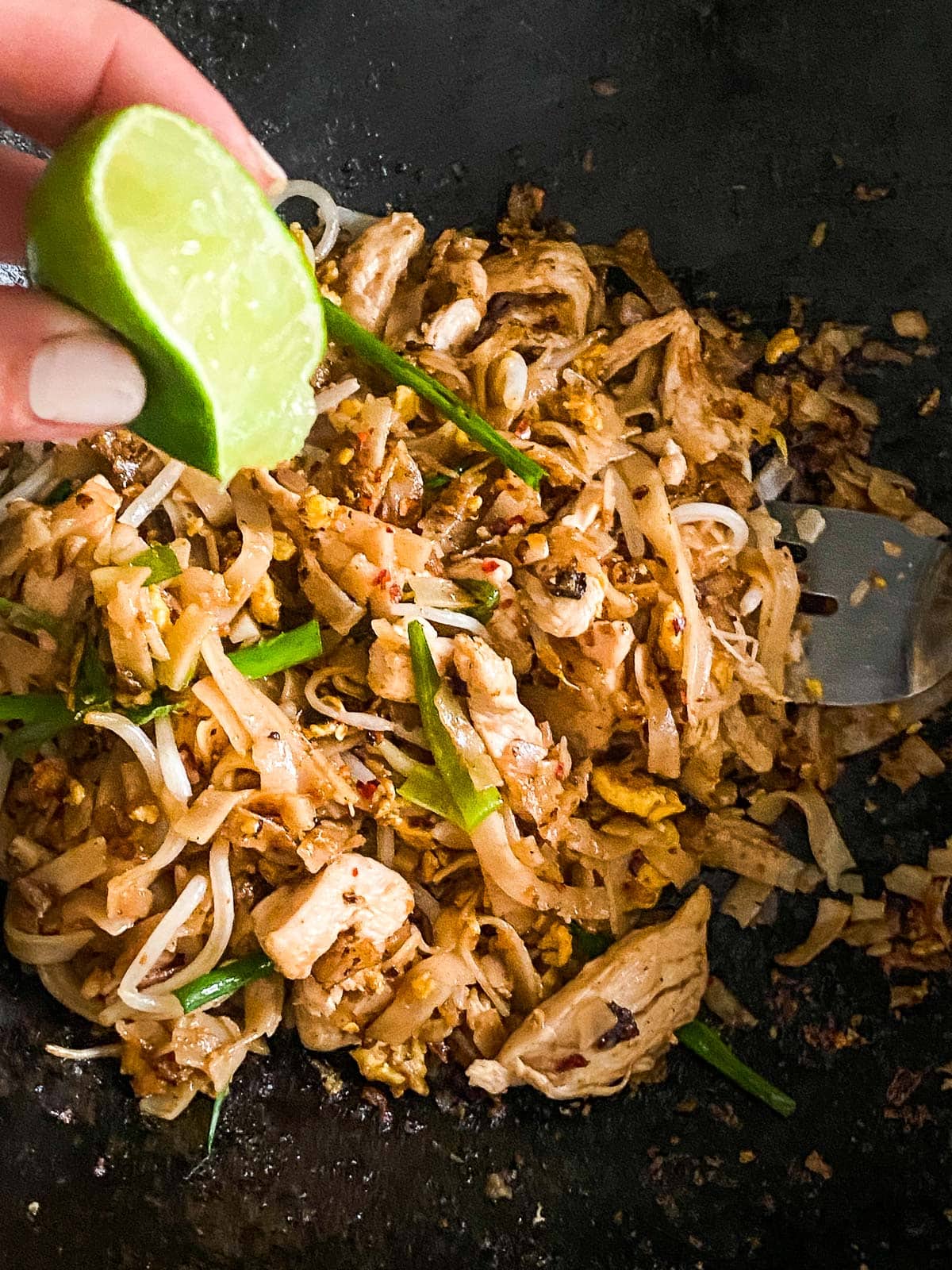
Step 7: Serve. Divide between 2-3 bowls and garnish with fresh bean sprouts, lime, wedge, crushed peanuts, chili flakes, scallions and basil. For extra heat, serve it with our chili garlic sauce!
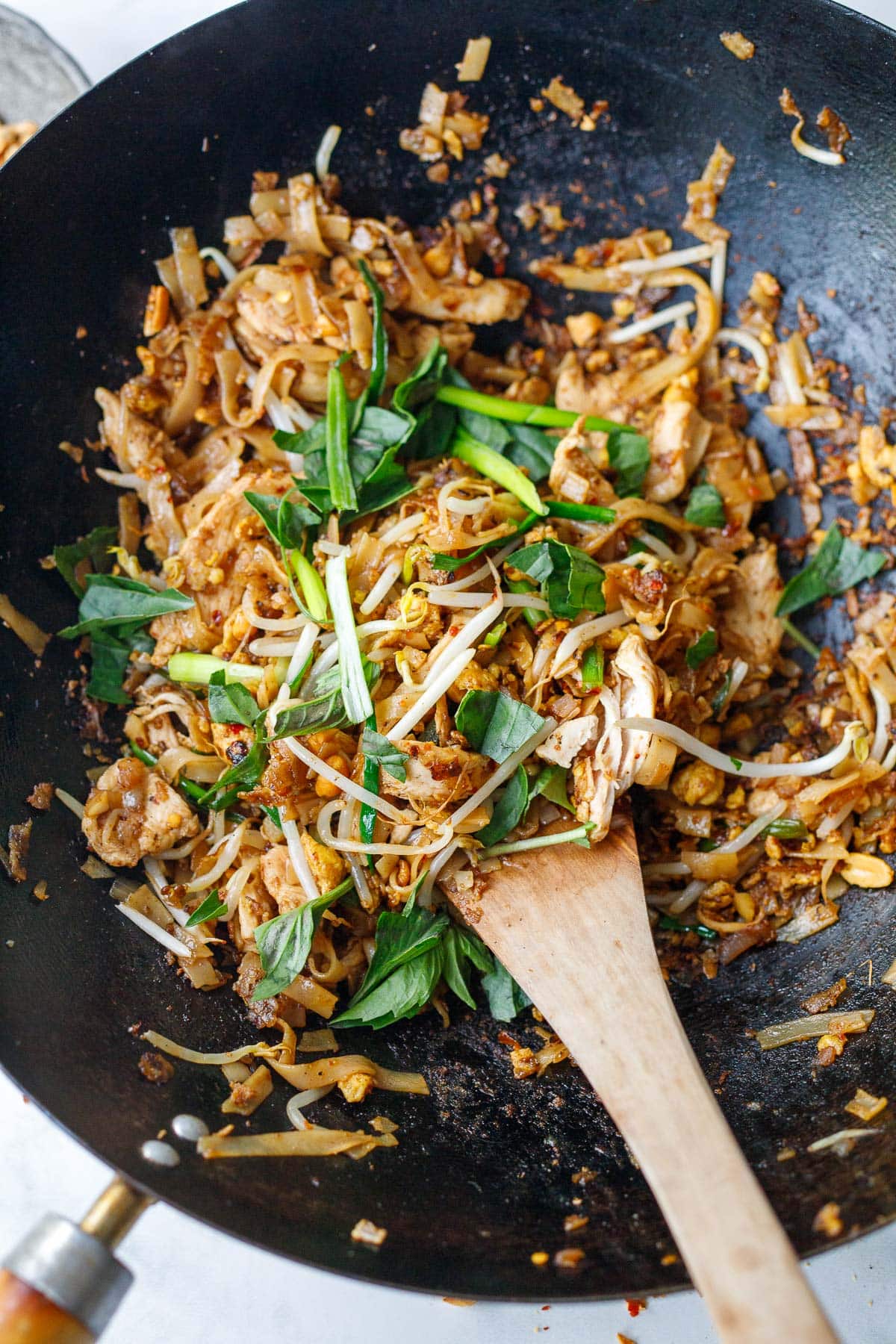
Pad Thai Noodle Tips
- Read the whole recipe through before you give it a go.
- Prep everything first, then place it near the stove. Cooking goes very fast here!
- Cut chicken very thinly to cut down on cooking time. Remember to cut across the grain, into ⅛ -¼ thin strips about two inches long.
- To lower calories, poach the chicken in a little salted water, until cooked through which just takes a couple of minutes. Then set it aside.
- Use shallot. Shallot adds so much flavor here- much more so than onion.
- Crispy noodles. Crisp up the rice noodles in the pan before adding the sauce.
- Let the Pad Thai sauce caramelize in the wok, before turning off the heat. This is the secret to the best flavor- a smoky sweetness we all crave!
Pad Thai Don’ts
- Please do not add ketchup or peanut butter. This is not authentic and takes away from the dish.
- Don’t use white vinegar instead of rice vinegar. White vinegar tastes way more acidic and it will be overly sour.
- Don’t skip the sweetener. you will lose the balance of the dish. You will end up with fishy, overly sour, salty Pad Thai that tastes terrible. TRUST ME.
- Don’t make too big of a batch. The noodles are stir-fried. You want the noodles to get slightly crispy in the pan, and the sugars to caramelize, giving them that incredible smoky flavor- this is difficult to achieve if making huge batches.
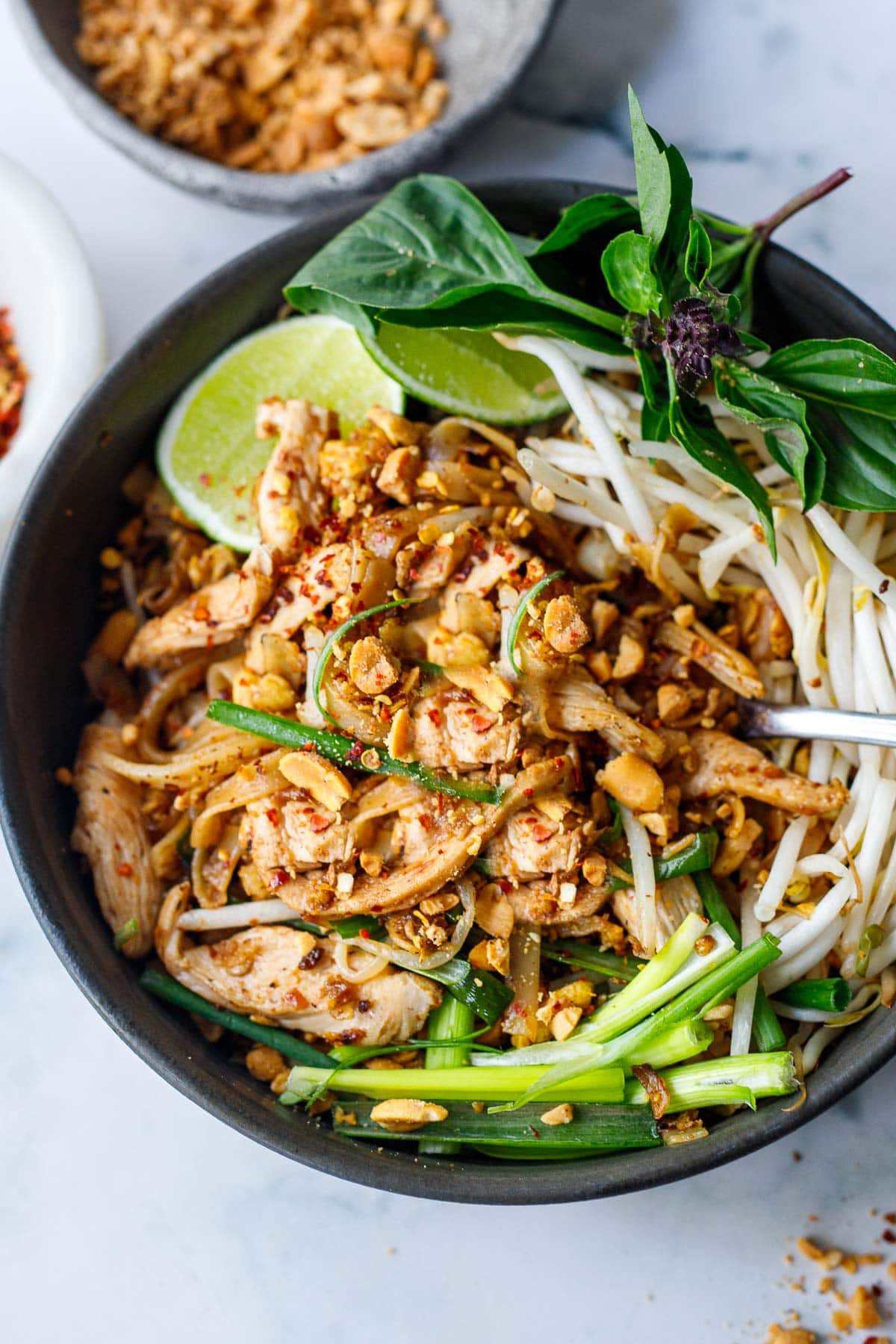
Serving Pad Thai Noodles
- Serve Pad Thai with lime wedges.
- Add fresh bean sprouts.
- Sprinkle with crushed roasted peanuts (or try this amazing Peanut Chili Crunch!)
- Add chopped scallions or Thai basil.
- Serve with Thai chili flakes, sriracha or chili paste for extra heat.
Storing Homemade Pad Thai
Pad Thai is best served right after it is cooked. Leftovers will last up to four days in an airtight container in the refrigerator. Reheat pad Thai in a skillet or wok, lightly stir frying.
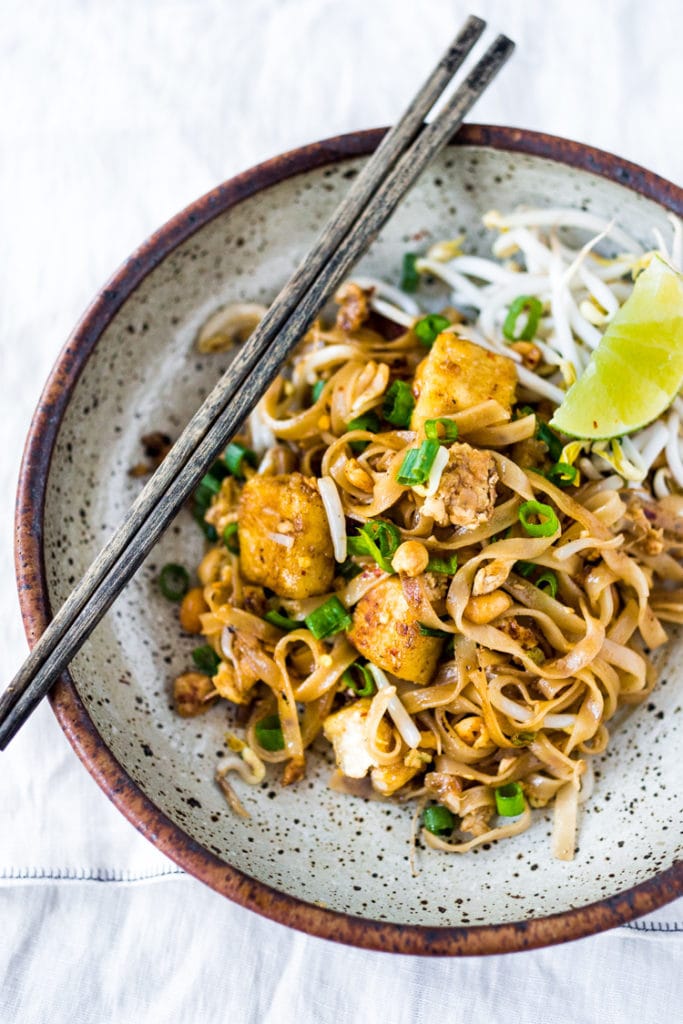
Pad Thai Recipe FAQs
Yes, Pad Thai can easily be made vegan. Use vegan fish sauce or soy sauce and crispy tofu as the protein, and leave out the eggs.
The secret to the best Pad Thai is not overcooking the rice noodles, using a very hot wok, cooking in smaller batches so rice noodles can caramelize, and having the perfect balance of flavors- not too sweet, not too sour, and not too salty.
Peanut oil adds the best flavor, while avocado and coconut oil both have a high smoke point. Both work well here. Any neutral high heat oil will work.
Any quick-cooking vegetables that can be cooked in a wok can be added to Pad Thai- asparagus, green beans, matchstick carrots, bell pepper and bok choy to name a few. Feel free to add steamed broccoli too!
Try adding a little more brown sugar and vinegar to balance it.
Add a little more brown sugar to balance it. White vinegar will do this- so always use rice wine vinegar, tamarind water or lime, which are all less acidic.
Add more acid ( rice vinegar, tamarind water or lime juice) to balance it.
What to serve with Pad Thai!
I hope that after you make this, you’ll think this is the best Pad Thai recipe you’ve ever had too! 😉 Haha! Let me know in the comments below! 🙂 Here are more of my favorite Fast, Easy Dinner Ideas!
Happy weekend.
xoxoxo
PS. It is my hope that through cooking, we not only learn new ingredients and techniques but also learn more about the culture and people from which the food we make originates. Cooking can be a way of celebrating all our unique and beautiful differences. I’d like to believe expanding our repertoire in the kitchen can also expand our hearts.
More Favorite Thai Noodle Dishes!
Love Thai Cuisine? Try…
- 33+ Easy Thai Recipes!
- Authentic Tom Kha Gai (Thai Coconut Chicken Soup)
- 30-Minute Thai Green Curry
- Thai Larb Salad
You may also love this Malaysian Char Kway Teow or Chickpea Curry!
More from Feasting At Home
How to make Pad Thai Noodles | Video
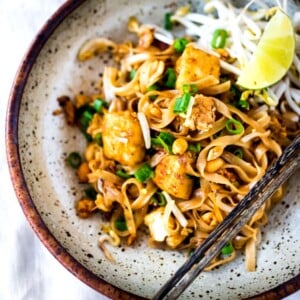
Easy Pad Thai (Chicken, Tofu or Shrimp)
- Prep Time: 15 mins
- Cook Time: 15 mins
- Total Time: 30 minutes
- Yield: 2
- Category: Main
- Method: stir-fried
- Cuisine: Thai
- Diet: Vegetarian
Description
An easy, 30-minute recipe for Pad Thai made with rice noodles, your choice of chicken, shrimp or tofu, scrambled eggs, and an incredible “not too sweet” Pad Thai Sauce. Makes 2 large servings. Watch the video!
Ingredients
- 4 ounces rice noodles
- 3 tablespoons peanut oil, divided ( or use avocado oil, or coconut oil)
- 8 ounces chicken breast, tofu or prawns (peeled and deveined)
- salt and pepper to taste
- 1 large shallot, finely diced (much better than onion here)
- 4 fat garlic cloves, roughly chopped
- 2 eggs, whisked with a fork with a generous 3-finger pinch salt if vegan, leave it out)
- 1 lime
- 1 1/2 cups bean sprouts
Pad Thai Sauce:
- 3 tablespoons fish sauce (see notes- or use vegan fish sauce)
- 3 tablespoons brown sugar (or coconut sugar, palm sugar, or regular sugar) see notes
- 3 tablespoons of rice wine vinegar (or tamarind water– see notes) do not sub white vinegar, it will be too sour.
- 2 teaspoons soy sauce (or GF liquid aminos like Braggs)
Garnish:
- lime wedges, fresh bean sprouts, chili flakes, chopped scallions, roasted peanuts, Thai basil
Instructions
- Soak the rice noodles. Place rice noodles in a shallow pan and cover with boiling water for 4-7 minutes, stirring occasionally (so they don’t stick together) until al dente; drain, rinse with cold water to stop cooking. They don’t have to be totally soft, just bendy and pliable.
- Whisk the two eggs in a bowl with a fork and add a generous, 3-finger pinch of salt. Set aside.
- Make the Pad Thai Sauce: whisk fish sauce, rice vinegar, brown sugar and soy sauce. (see notes) in a small bowl. Set aside.
- Prep the protein. Chicken: slice chicken into very thin strips and season with salt and pepper. Crispy Tofu: Blot tofu with paper towels pressing down firmly. Cut tofu into ¾ inch cubes, sprinkle with salt and pepper, and for extra crispy, dredge in a little corn starch. Shrimp: season with salt and pepper.
- Cook the protein: Heat 1 tablespoon oil in a large saucepan or wok, over medium-high heat. Sear the seasoned chicken, shrimp or tofu until cooked through. Set aside,
- Stir Fry: Gather your chopped shallots and garlic, whisked eggs, cooked noodles, cooked protein and Pad Thai Sauce around the stove. Heat a little more oil in the wok over medium heat, add shallot & garlic and stir fry 2-3 minutes. Scoot the shallot mixture to the side, add more oil, and pour in the eggs. Scramble and break them apart into little bits, and move them to the side. Add more oil, and the noodles, stirfry 2-3 minutes until noodles are soft and pliable and even a little crispy.
- Pour in the Pad Thai Sauce (turn hood on) stir everything together and cook 1-2 minute, then add the cooked protein and stirfry for a few more minutes. Just as you start to smell the sugar carmelizing, you are there! Squeeze with a little lime juice. Turn off heat.
- Taste. Adjust salt, lime, heat and sweetness to your liking; add salt, or soy sauce for more depth if you like, a squeeze of lime juice, chili flakes, or a pinch of sugar to taste.
- Toss in 1/2 the bean sprouts and roasted peanuts (or serve on the side) and sprinkle with chili flakes and scallions. Give one more toss and serve immediately. Divide among two plates.
- Garnish with more bean sprouts, fresh scallions, cilantro or basil, chili flakes, lime wedges and roasted crushed peanuts. Or make this Peanut Chili Crunch!
Equipment
Notes
Fish Sauce: If you are not accustomed to fish sauce, or are using a brand you haven’t tried before (some are fishier than others) feel free to go lighter on the fish sauce– like 2 tablespoons. If going with less, replace it with soy sauce.
Poach the chicken. An easy way to cut back on the oil in the recipe is to poach the thinly sliced chicken breast in a little salted water, or broth for a few minutes, until cooked through. Drain and set aside. The thinner you slice the chicken the faster it will cook.
Tamarind: If using tamarind paste (instead of rice vinegar) make tamarind “water” by mixing 1 tablespoon tamarind paste with 2 1/2 tablespoons hot water. If using tamarind “concentrate” mix 1-2 teaspoons with 2 1/2 tablespoons water. Use tamarind water in place of the vinegar. Using tamarind is more authentic but not everyone has access to it. Tamarind is extremely sour so if unfamiliar, go light. You can always add more lime to taste.
Nutrition
- Serving Size: 1 ½ cups
- Calories: 409
- Sugar: 14.3 g
- Sodium: 1134 mg
- Fat: 14.2 g
- Saturated Fat: 2.1 g
- Carbohydrates: 47.4 g
- Fiber: 1.1 g
- Protein: 20.5 g
- Cholesterol: 165.4 mg
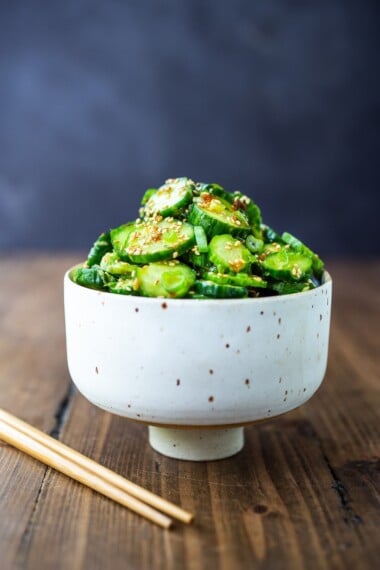
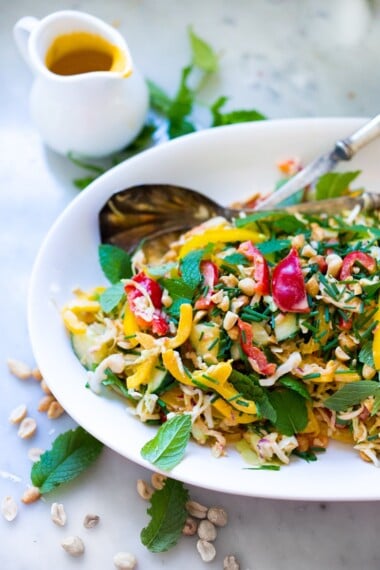
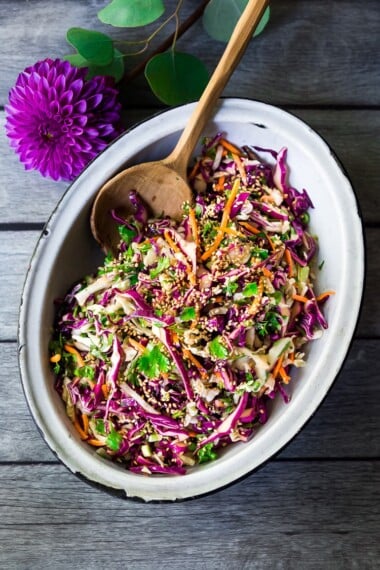
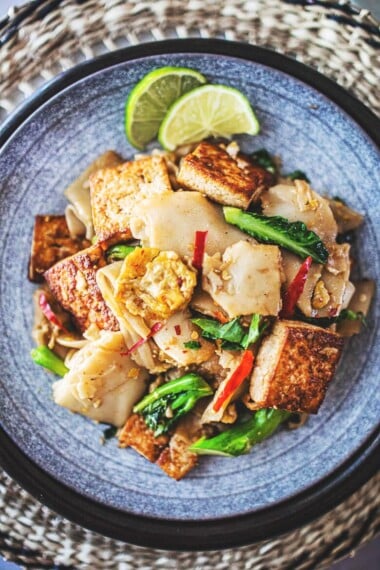
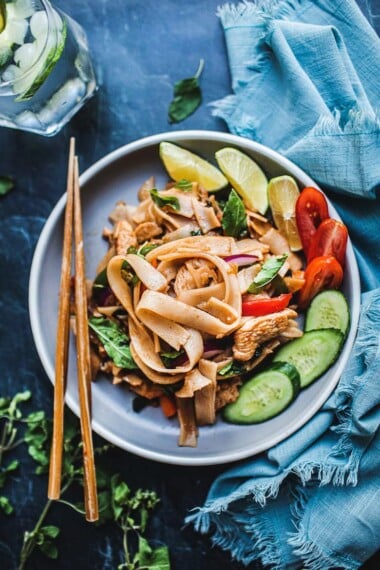
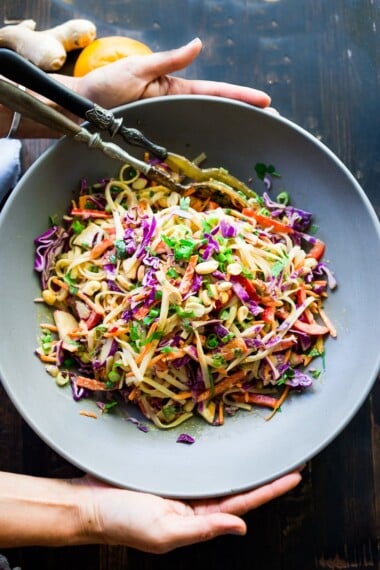
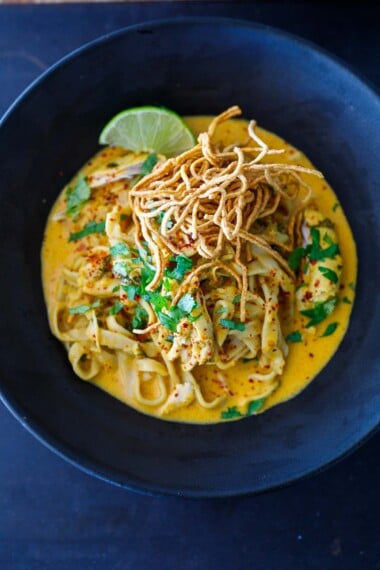
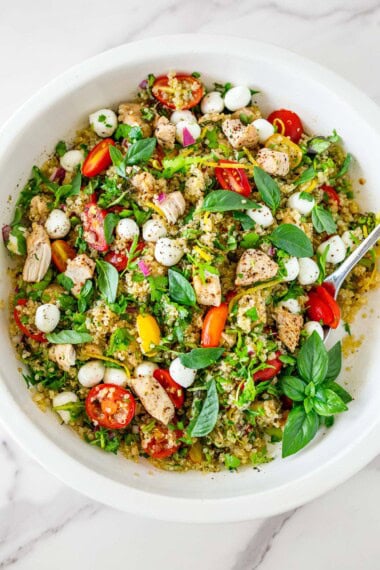
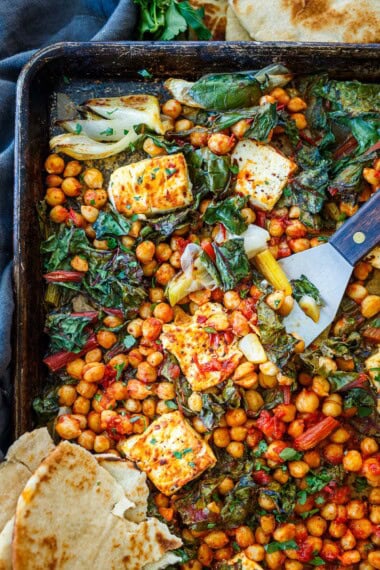
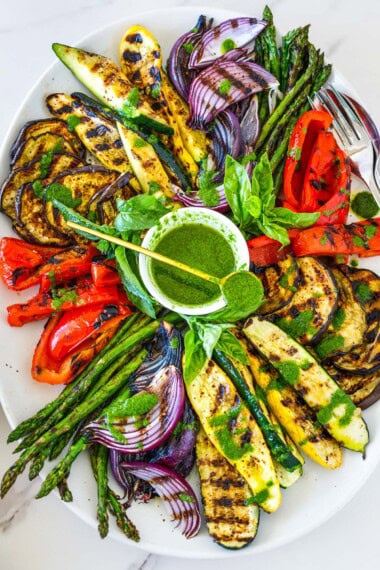



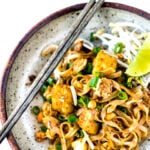
4 ounces of Rice Noodles? IE- the link redirects to a 14oz box.
Is this correct b/c I dont see multiplying the sauce directions by a factor or 3.5 when using the entire box.
Yes, correct Jim, the noodles really don’t come in a 4-ounce box. So you’ll have enough to make more. 😉
This recipe tastes EXACTLY like my local Thai restaurant. Now I swap in sesame oil for cooking, add a 1/4 tsp of key lime juice to the sauce, and I top it with chopped honey roasted peanuts and red pepper flakes for a spicy-sweet crunchy kick.
So glad I found this recipe! My spouse doesn’t even mind the fish sauce smell when I make it because she knows something good is coming soon 🙂
Awesome Kai! glad this worked for you!
I’ve made this about five times now and my teenagers LOVE it. Fresh and delicious
Great to hear Amy! I’m constantly surprised how often I hear that kids enjoy this one. It means you got the balance, just right!
Thank you for another great recipe. Your website is the first place I go before cooking a meal. Thank you for sharing your knowledge. This recipe was easy & the kids loved it!
Thanks so much Alisa!
Super easy and the best pad thai I’ve ever made at home. I recommend making it with tamarind!
Thanks so much Susie!
Delicious!! 🤤
You inadvertently left bean sprouts off the list of ingredients—
Hey Scott- they are listed in the garnishes
This was so good! And simple! I substituted xylitol for the sugar, and brown rice pad thai noodles instead of regular, and it was amazing! I added some broccoli. Yum. Thanks for the recipe!
Perfect – glad you enjoyed it
Excellent. Be sure to have everything prepped ahead. It really does go so quickly! It is so easy and delicious. I’ll be making this often.
Awesome Skye- thanks so much!
Easy recipe. However mine turned out far too salty and I reduced the fish sauce. My brand of fish sauce has 1600 mg of sodium per tbs, never having used it before, Is that common? Unfortunately, I had not read the label when purchasing. I’ll definitely try it again.
That is the challenge here- all fish sauce brands have different levels of salt. That does seem higher to me.
This recipe is amazing. The flavors are bright and fresh. Made this for my two busy mom besties and they loved it. So did the kiddos that kept sneaking bites. Such a pleasure to make a deeply satisfying meal for friends. Thank you!
Awesome Shannon! Glad you all enjoyed!
This is so true:
“PS. It is my hope that through cooking, we not only learn new ingredients and techniques but also learn more about the culture and people from which the food we make originates. Cooking can be a way of celebrating all our unique and beautiful differences. I’d like to believe expanding our repertoire in the kitchen can also expand our hearts. ”
♥️ ♥️ ♥️
Thanks Ineke!
So good! Loved it! This will be on my regular dinner rotation from now on. 🙂
Thanks Mimi!
I tried this tonight and it was absolutely delicious. I used red onions instead of shallots and doubled the pad Thai sauce. Thank you for a great recipe.
Thanks so much Jaci!
Hi Loren, did you use extra noodles?
<3
💛
Excellent recipe. I managed to double the recipe in my wok pan . Probably a smaller pan wouldn’t have worked to do such. I’d be making this again . Took me time as I was doing the recipe first time and being very careful abt getting the amount of ingredients right esp for the pad thai sauce. Fish sauce smells and taste horrible in my opinion but works wonders as a cooking ingredient. Thank you so much for sharing this .
Great to hear Zoya- glad you enjoyed this!
This recipe was excellent! I’ve never made pad thai sauce from scratch, so it was a very tasty experiment. I used an anchovy-based fish sauce and reduced the amount slightly, while slightly increasing the soy sauce to even out the saltiness. I wasn’t sure about the poached chicken method (especially since the poached chicken smelled a little weird to me!) but it mixed beautifully with the noodles and sauce and ended up perfectly seasoned.
I did leave out the bean sprouts and peanuts due to preference, but added lots of fresh lime, scallions and cilantro. It is very easy to tailor this dish to your preferences.
I’ve always been afraid to use fish sauce due to its pungency but this recipe increased my confidence! Now I want to try it with tofu and shrimp!
This is so great to hear Khan! Love that you tried something new. 👏🏼
Very good recipe. Thank you. One thing I added to the sauce is peanut butter creamy since I do not use peanut oil. I used olive oil. In addition, I used dark soy sauce to make to noodle more colorful. I also added sweet color pepper.
Glad this worked for you!
Awesome recipe! Thank you for creating and sharing these recipes. Made the vegan sauce with mushrooms and seaweed. Excellent flavour. First time making pad thai completely vegan. Everyone enjoyed it. Thank you very much!
Awesome and great to hear!
When it said “gather near the stove” I thought you meant gather all of the ingredients together and I mixed it all before frying it :/ still tasted good though
Oh no! Shoot!
Made this last night and it was so easy, delicious and versatile (chicken, shrimp, tofu). Never ordering take-out Pad Thai again. Definitely a keeper!
Yay Cynthia! Glad you enjoyed it!
Thank you so much! This was such an easy recipe to follow and absolutely delicious! No more ordering in 🙂
I appreciated the modification notes about fish sauce (used 2 Tbsp instead of 3) and also the flavour adjustment recommendations for individual preferences. For me, it was a bit of extra lime and a very happy outcome. Like other reviewers, I have added this recipe to my ‘regulars’ list now!
Awesome Jenna- thanks!
Sorry this didn’t work for you
Absolutely delicious. Having never made this dish I loved the simplicity. Taste was amazing. I also think I have found a love for tofu. Thank you
Glad you enjoyed this!